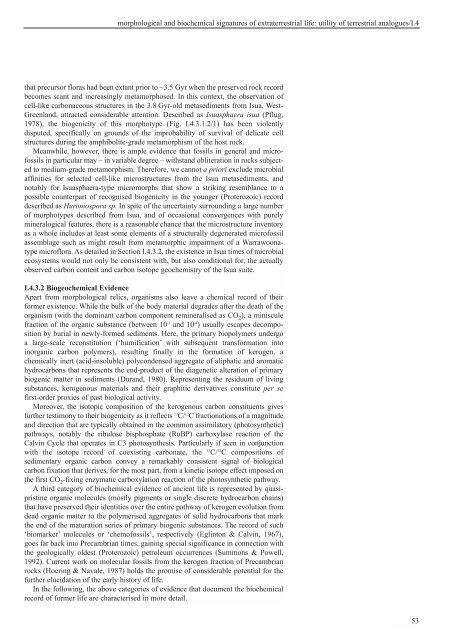Exobiology in the Solar System & The Search for Life on Mars - ESA
Exobiology in the Solar System & The Search for Life on Mars - ESA
Exobiology in the Solar System & The Search for Life on Mars - ESA
You also want an ePaper? Increase the reach of your titles
YUMPU automatically turns print PDFs into web optimized ePapers that Google loves.
morphological and biochemical signatures of extraterrestrial life: utility of terrestrial analogues/I.4<br />
that precursor floras had been extant prior to ~3.5 Gyr when <str<strong>on</strong>g>the</str<strong>on</strong>g> preserved rock record<br />
becomes scant and <str<strong>on</strong>g>in</str<strong>on</strong>g>creas<str<strong>on</strong>g>in</str<strong>on</strong>g>gly metamorphosed. In this c<strong>on</strong>text, <str<strong>on</strong>g>the</str<strong>on</strong>g> observati<strong>on</strong> of<br />
cell-like carb<strong>on</strong>aceous structures <str<strong>on</strong>g>in</str<strong>on</strong>g> <str<strong>on</strong>g>the</str<strong>on</strong>g> 3.8 Gyr-old metasediments from Isua, West-<br />
Greenland, attracted c<strong>on</strong>siderable attenti<strong>on</strong>. Described as Isuasphaera isua (Pflug,<br />
1978), <str<strong>on</strong>g>the</str<strong>on</strong>g> biogenicity of this morphotype (Fig. I.4.3.1.2/1) has been violently<br />
disputed, specifically <strong>on</strong> grounds of <str<strong>on</strong>g>the</str<strong>on</strong>g> improbability of survival of delicate cell<br />
structures dur<str<strong>on</strong>g>in</str<strong>on</strong>g>g <str<strong>on</strong>g>the</str<strong>on</strong>g> amphibolite-grade metamorphism of <str<strong>on</strong>g>the</str<strong>on</strong>g> host rock.<br />
Meanwhile, however, <str<strong>on</strong>g>the</str<strong>on</strong>g>re is ample evidence that fossils <str<strong>on</strong>g>in</str<strong>on</strong>g> general and microfossils<br />
<str<strong>on</strong>g>in</str<strong>on</strong>g> particular may – <str<strong>on</strong>g>in</str<strong>on</strong>g> variable degree – withstand obliterati<strong>on</strong> <str<strong>on</strong>g>in</str<strong>on</strong>g> rocks subjected<br />
to medium-grade metamorphism. <str<strong>on</strong>g>The</str<strong>on</strong>g>re<str<strong>on</strong>g>for</str<strong>on</strong>g>e, we cannot a priori exclude microbial<br />
aff<str<strong>on</strong>g>in</str<strong>on</strong>g>ities <str<strong>on</strong>g>for</str<strong>on</strong>g> selected cell-like microstructures from <str<strong>on</strong>g>the</str<strong>on</strong>g> Isua metasediments, and<br />
notably <str<strong>on</strong>g>for</str<strong>on</strong>g> Isuasphaera-type micromorphs that show a strik<str<strong>on</strong>g>in</str<strong>on</strong>g>g resemblance to a<br />
possible counterpart of recognised biogenicity <str<strong>on</strong>g>in</str<strong>on</strong>g> <str<strong>on</strong>g>the</str<strong>on</strong>g> younger (Proterozoic) record<br />
described as Hur<strong>on</strong>iospora sp. In spite of <str<strong>on</strong>g>the</str<strong>on</strong>g> uncerta<str<strong>on</strong>g>in</str<strong>on</strong>g>ty surround<str<strong>on</strong>g>in</str<strong>on</strong>g>g a large number<br />
of morphotypes described from Isua, and of occasi<strong>on</strong>al c<strong>on</strong>vergences with purely<br />
m<str<strong>on</strong>g>in</str<strong>on</strong>g>eralogical features, <str<strong>on</strong>g>the</str<strong>on</strong>g>re is a reas<strong>on</strong>able chance that <str<strong>on</strong>g>the</str<strong>on</strong>g> microstructure <str<strong>on</strong>g>in</str<strong>on</strong>g>ventory<br />
as a whole <str<strong>on</strong>g>in</str<strong>on</strong>g>cludes at least some elements of a structurally degenerated microfossil<br />
assemblage such as might result from metamorphic impairment of a Warrawo<strong>on</strong>atype<br />
microflora. As detailed <str<strong>on</strong>g>in</str<strong>on</strong>g> Secti<strong>on</strong> I.4.3.2, <str<strong>on</strong>g>the</str<strong>on</strong>g> existence <str<strong>on</strong>g>in</str<strong>on</strong>g> Isua times of microbial<br />
ecosystems would not <strong>on</strong>ly be c<strong>on</strong>sistent with, but also c<strong>on</strong>diti<strong>on</strong>al <str<strong>on</strong>g>for</str<strong>on</strong>g>, <str<strong>on</strong>g>the</str<strong>on</strong>g> actually<br />
observed carb<strong>on</strong> c<strong>on</strong>tent and carb<strong>on</strong> isotope geochemistry of <str<strong>on</strong>g>the</str<strong>on</strong>g> Isua suite.<br />
I.4.3.2 Biogeochemical Evidence<br />
Apart from morphological relics, organisms also leave a chemical record of <str<strong>on</strong>g>the</str<strong>on</strong>g>ir<br />
<str<strong>on</strong>g>for</str<strong>on</strong>g>mer existence. While <str<strong>on</strong>g>the</str<strong>on</strong>g> bulk of <str<strong>on</strong>g>the</str<strong>on</strong>g> body material degrades after <str<strong>on</strong>g>the</str<strong>on</strong>g> death of <str<strong>on</strong>g>the</str<strong>on</strong>g><br />
organism (with <str<strong>on</strong>g>the</str<strong>on</strong>g> dom<str<strong>on</strong>g>in</str<strong>on</strong>g>ant carb<strong>on</strong> comp<strong>on</strong>ent rem<str<strong>on</strong>g>in</str<strong>on</strong>g>eralised as CO 2), a m<str<strong>on</strong>g>in</str<strong>on</strong>g>iscule<br />
fracti<strong>on</strong> of <str<strong>on</strong>g>the</str<strong>on</strong>g> organic substance (between 10 -3 and 10 -4 ) usually escapes decompositi<strong>on</strong><br />
by burial <str<strong>on</strong>g>in</str<strong>on</strong>g> newly-<str<strong>on</strong>g>for</str<strong>on</strong>g>med sediments. Here, <str<strong>on</strong>g>the</str<strong>on</strong>g> primary biopolymers undergo<br />
a large-scale rec<strong>on</strong>stituti<strong>on</strong> (‘humificati<strong>on</strong>’ with subsequent trans<str<strong>on</strong>g>for</str<strong>on</strong>g>mati<strong>on</strong> <str<strong>on</strong>g>in</str<strong>on</strong>g>to<br />
<str<strong>on</strong>g>in</str<strong>on</strong>g>organic carb<strong>on</strong> polymers), result<str<strong>on</strong>g>in</str<strong>on</strong>g>g f<str<strong>on</strong>g>in</str<strong>on</strong>g>ally <str<strong>on</strong>g>in</str<strong>on</strong>g> <str<strong>on</strong>g>the</str<strong>on</strong>g> <str<strong>on</strong>g>for</str<strong>on</strong>g>mati<strong>on</strong> of kerogen, a<br />
chemically <str<strong>on</strong>g>in</str<strong>on</strong>g>ert (acid-<str<strong>on</strong>g>in</str<strong>on</strong>g>soluble) polyc<strong>on</strong>densed aggregate of aliphatic and aromatic<br />
hydrocarb<strong>on</strong>s that represents <str<strong>on</strong>g>the</str<strong>on</strong>g> end-product of <str<strong>on</strong>g>the</str<strong>on</strong>g> diagenetic alterati<strong>on</strong> of primary<br />
biogenic matter <str<strong>on</strong>g>in</str<strong>on</strong>g> sediments (Durand, 1980). Represent<str<strong>on</strong>g>in</str<strong>on</strong>g>g <str<strong>on</strong>g>the</str<strong>on</strong>g> residuum of liv<str<strong>on</strong>g>in</str<strong>on</strong>g>g<br />
substances, kerogenous materials and <str<strong>on</strong>g>the</str<strong>on</strong>g>ir graphitic derivatives c<strong>on</strong>stitute per se<br />
first-order proxies of past biological activity.<br />
Moreover, <str<strong>on</strong>g>the</str<strong>on</strong>g> isotopic compositi<strong>on</strong> of <str<strong>on</strong>g>the</str<strong>on</strong>g> kerogenous carb<strong>on</strong> c<strong>on</strong>stituents gives<br />
fur<str<strong>on</strong>g>the</str<strong>on</strong>g>r testim<strong>on</strong>y to <str<strong>on</strong>g>the</str<strong>on</strong>g>ir biogenicity as it reflects 13 C/ 12 C fracti<strong>on</strong>ati<strong>on</strong>s of a magnitude<br />
and directi<strong>on</strong> that are typically obta<str<strong>on</strong>g>in</str<strong>on</strong>g>ed <str<strong>on</strong>g>in</str<strong>on</strong>g> <str<strong>on</strong>g>the</str<strong>on</strong>g> comm<strong>on</strong> assimilatory (photosyn<str<strong>on</strong>g>the</str<strong>on</strong>g>tic)<br />
pathways, notably <str<strong>on</strong>g>the</str<strong>on</strong>g> ribulose bisphosphate (RuBP) carboxylase reacti<strong>on</strong> of <str<strong>on</strong>g>the</str<strong>on</strong>g><br />
Calv<str<strong>on</strong>g>in</str<strong>on</strong>g> Cycle that operates <str<strong>on</strong>g>in</str<strong>on</strong>g> C3 photosyn<str<strong>on</strong>g>the</str<strong>on</strong>g>sis. Particularly if seen <str<strong>on</strong>g>in</str<strong>on</strong>g> c<strong>on</strong>juncti<strong>on</strong><br />
with <str<strong>on</strong>g>the</str<strong>on</strong>g> isotope record of coexist<str<strong>on</strong>g>in</str<strong>on</strong>g>g carb<strong>on</strong>ate, <str<strong>on</strong>g>the</str<strong>on</strong>g> 13 C/ 12 C compositi<strong>on</strong>s of<br />
sedimentary organic carb<strong>on</strong> c<strong>on</strong>vey a remarkably c<strong>on</strong>sistent signal of biological<br />
carb<strong>on</strong> fixati<strong>on</strong> that derives, <str<strong>on</strong>g>for</str<strong>on</strong>g> <str<strong>on</strong>g>the</str<strong>on</strong>g> most part, from a k<str<strong>on</strong>g>in</str<strong>on</strong>g>etic isotope effect imposed <strong>on</strong><br />
<str<strong>on</strong>g>the</str<strong>on</strong>g> first CO 2-fix<str<strong>on</strong>g>in</str<strong>on</strong>g>g enzymatic carboxylati<strong>on</strong> reacti<strong>on</strong> of <str<strong>on</strong>g>the</str<strong>on</strong>g> photosyn<str<strong>on</strong>g>the</str<strong>on</strong>g>tic pathway.<br />
A third category of biochemical evidence of ancient life is represented by quasiprist<str<strong>on</strong>g>in</str<strong>on</strong>g>e<br />
organic molecules (mostly pigments or s<str<strong>on</strong>g>in</str<strong>on</strong>g>gle discrete hydrocarb<strong>on</strong> cha<str<strong>on</strong>g>in</str<strong>on</strong>g>s)<br />
that have preserved <str<strong>on</strong>g>the</str<strong>on</strong>g>ir identities over <str<strong>on</strong>g>the</str<strong>on</strong>g> entire pathway of kerogen evoluti<strong>on</strong> from<br />
dead organic matter to <str<strong>on</strong>g>the</str<strong>on</strong>g> polymerised aggregates of solid hydrocarb<strong>on</strong>s that mark<br />
<str<strong>on</strong>g>the</str<strong>on</strong>g> end of <str<strong>on</strong>g>the</str<strong>on</strong>g> maturati<strong>on</strong> series of primary biogenic substances. <str<strong>on</strong>g>The</str<strong>on</strong>g> record of such<br />
‘biomarker’ molecules or ‘chemofossils’, respectively (Egl<str<strong>on</strong>g>in</str<strong>on</strong>g>t<strong>on</strong> & Calv<str<strong>on</strong>g>in</str<strong>on</strong>g>, 1967),<br />
goes far back <str<strong>on</strong>g>in</str<strong>on</strong>g>to Precambrian times, ga<str<strong>on</strong>g>in</str<strong>on</strong>g><str<strong>on</strong>g>in</str<strong>on</strong>g>g special significance <str<strong>on</strong>g>in</str<strong>on</strong>g> c<strong>on</strong>necti<strong>on</strong> with<br />
<str<strong>on</strong>g>the</str<strong>on</strong>g> geologically oldest (Proterozoic) petroleum occurrences (Summ<strong>on</strong>s & Powell,<br />
1992). Current work <strong>on</strong> molecular fossils from <str<strong>on</strong>g>the</str<strong>on</strong>g> kerogen fracti<strong>on</strong> of Precambrian<br />
rocks (Hoer<str<strong>on</strong>g>in</str<strong>on</strong>g>g & Navale, 1987) holds <str<strong>on</strong>g>the</str<strong>on</strong>g> promise of c<strong>on</strong>siderable potential <str<strong>on</strong>g>for</str<strong>on</strong>g> <str<strong>on</strong>g>the</str<strong>on</strong>g><br />
fur<str<strong>on</strong>g>the</str<strong>on</strong>g>r elucidati<strong>on</strong> of <str<strong>on</strong>g>the</str<strong>on</strong>g> early history of life.<br />
In <str<strong>on</strong>g>the</str<strong>on</strong>g> follow<str<strong>on</strong>g>in</str<strong>on</strong>g>g, <str<strong>on</strong>g>the</str<strong>on</strong>g> above categories of evidence that document <str<strong>on</strong>g>the</str<strong>on</strong>g> biochemical<br />
record of <str<strong>on</strong>g>for</str<strong>on</strong>g>mer life are characterised <str<strong>on</strong>g>in</str<strong>on</strong>g> more detail.<br />
53

















